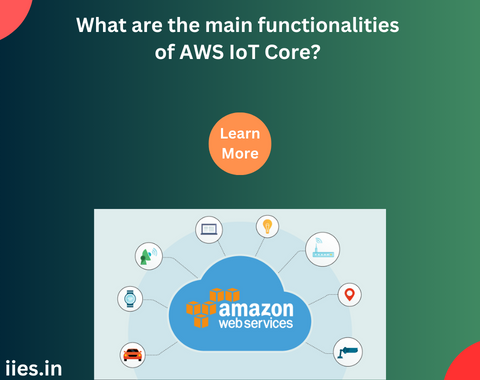
In the ever-evolving landscape of technology, the Internet of Things (IoT) has emerged as a transformative force, connecting devices, sensors, and systems to enable smarter and more efficient operations. At the forefront of IoT solutions is Amazon Web Services (AWS) IoT Core, a robust and scalable platform that facilitates seamless communication and management of IoT devices. In this article, we will delve into the main functionalities of AWS IoT Core and explore how it plays a pivotal role in shaping the future of connected devices.
At the heart of AWS IoT Core lies its ability to establish secure and reliable connectivity between devices and the cloud. The platform supports a variety of communication protocols, including MQTT (Message Queuing Telemetry Transport), HTTP, and WebSockets, ensuring flexibility in connecting a diverse range of devices. This enables IoT devices to effortlessly send and receive data, fostering real-time communication for applications ranging from smart homes to industrial automation.
Device Registry and Management:
AWS IoT Core provides a centralized device registry that serves as a comprehensive repository for managing information about all connected devices. This registry allows developers and administrators to organize and track devices, providing essential metadata such as device IDs, attributes, and connectivity status. Through the AWS Management Console or APIs, users can efficiently onboard, configure, and update device information, streamlining the process of managing large-scale IoT deployments.
Security and Identity Management:
Security is paramount in the IoT ecosystem, and AWS IoT Core addresses this concern through robust identity and access management mechanisms. The platform supports authentication and authorization through the use of X.509 certificates, IAM (Identity and Access Management) policies, and custom authorizers. This ensures that only authorized devices can interact with the IoT Core, safeguarding sensitive data and preventing unauthorized access.
Device Shadows:
One of the innovative features of AWS IoT Core is the concept of device shadows. Device shadows act as a virtual representation of the physical devices connected to the IoT Core, allowing for seamless communication even when the device is offline. This abstraction simplifies application development, enabling applications to interact with the virtual device shadow, which in turn syncs with the actual device once it comes online. This capability is particularly valuable for building resilient and responsive IoT applications.
Rule Engine and Message Processing:
The Rule Engine in AWS IoT Core empowers users to define rules for processing and acting upon incoming messages from devices. Leveraging SQL-like syntax, users can create rules to filter, transform, and route messages based on specific criteria. This enables the implementation of business logic at the edge, reducing latency and optimizing the utilization of cloud resources. Additionally, AWS IoT Core supports integration with other AWS services, allowing seamless interaction with databases, storage, and analytics tools.
Device Communication and Shadow Actions:
AWS IoT Core facilitates bidirectional communication between devices and applications through the use of Device Gateway and Device Shadow service. Devices can publish messages to topics, and subscribers (applications or other devices) can subscribe to these topics to receive real-time updates. Moreover, the platform enables devices to update their shadow state, triggering corresponding actions on the device when changes occur. This mechanism enhances the responsiveness and interactivity of IoT applications.
Integration with AWS IoT Analytics and other Services:
AWS IoT Core seamlessly integrates with various other AWS services, extending its capabilities and enabling the creation of end-to-end IoT solutions. Integration with AWS IoT Analytics allows users to analyze and gain insights from IoT data, while coupling with AWS Lambda facilitates serverless computing for executing custom logic in response to IoT events. The flexibility of integration empowers developers to build sophisticated and scalable IoT applications tailored to specific business needs.
Scalability and Global Reach:
Scalability is a fundamental characteristic of AWS IoT Core, allowing organizations to accommodate the growing number of connected devices effortlessly. The platform can handle millions of simultaneous connections, ensuring a smooth and reliable experience for users. Additionally, AWS IoT Core supports global deployments, enabling the distribution of IoT workloads across multiple regions for enhanced performance and availability.
Device Monitoring and Logging:
Monitoring the health and performance of IoT devices is critical for ensuring the reliability and effectiveness of an IoT solution. AWS IoT Core offers robust monitoring and logging capabilities, allowing users to track metrics such as device connections, message rates, and errors. CloudWatch, a native AWS service, seamlessly integrates with IoT Core, providing a centralized location for monitoring and visualizing key performance indicators. This ensures that administrators can proactively identify and address issues, optimizing the overall efficiency of the IoT deployment.
Over-the-Air (OTA) Updates:
Managing and updating the firmware or software of IoT devices can be a complex task, especially at scale. AWS IoT Core simplifies this process through its Over-the-Air (OTA) update functionality. This feature enables organizations to remotely deploy updates to IoT devices,
Custom Endpoints and White-Labeling:
AWS IoT Core allows users to customize their MQTT endpoints, providing flexibility in designing a branded and white-labeled IoT solution. This is particularly valuable for enterprises and businesses looking to offer IoT services under their own brand.
Integration with AWS IoT Greengrass:
For edge computing scenarios, AWS IoT Core seamlessly integrates with AWS IoT Greengrass. AWS IoT Greengrass extends the capabilities of AWS IoT to the edge of the network, allowing devices to perform computing tasks locally and reduce latency.
In conclusion, AWS IoT Core stands as a cornerstone in the world of IoT, providing a comprehensive and powerful platform for connecting, managing, and securing IoT devices. From device connectivity and communication to advanced features like device shadows and rule-based message processing, AWS IoT Core empowers developers to build scalable, secure, and responsive IoT applications. As the IoT landscape continues to evolve, AWS IoT Core remains at the forefront, driving innovation and enabling businesses to harness the full potential of connected devices.
Indian Institute of Embedded Systems – IIES